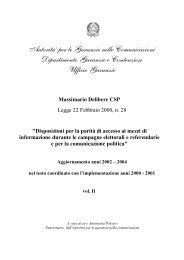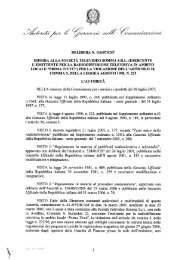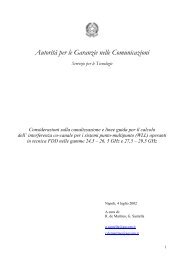Communications Regulatory Authority
Communications Regulatory Authority
Communications Regulatory Authority
You also want an ePaper? Increase the reach of your titles
YUMPU automatically turns print PDFs into web optimized ePapers that Google loves.
having the availability, on an exclusive basis and on all distribution platforms, of<br />
particularly attractive content (in particular, football and newly released films), thus<br />
hindering the development of the competitive process taking place among the media.<br />
Apropos of this, the case of the sale of the “Premier League” rights for the 2007-<br />
2010 period is significant. The European Commission intervened, ordering the English<br />
first division league to sell the rights of the matches, breaking them down into six<br />
packets, thereby prohibiting the exclusive acquisition of all the matches by just a single<br />
supplier. The aim of the action is to increase the availability of the rights, and therefore<br />
to help competition among the various technological platforms. At the end of the<br />
auction, the rights were won in part by BSkyB (for a total of 92 games) and in part by<br />
the Irish pay-TV broadcaster Setanta. BSkyB, which since 1992 had always won the<br />
exclusive rights for the Premier League, thus had to enter into an agreement with the<br />
Irish operator to enable its business and residential users to have access to all the<br />
matches. Setanta also intends to make the matches available in pay-per-view mode on<br />
the Freeview (digital terrestrial) and NTL (cable) platforms.<br />
Lastly, it is necessary to remember the revision process in course with regard to<br />
the “TV without Frontiers” directive by the European Commission (cf. paragraph 3.1.).<br />
The purpose is to create a harmonised regulatory context that also contemplates the<br />
most innovative content distribution modes, at present governed by other Community<br />
directives, and which also takes into account the new forms of advertising that are<br />
gaining ground. The directive must create a regulatory context that fosters innovation<br />
and competition in the offering of television content, preserving the principle of<br />
technological neutrality among the broadcasting platforms.<br />
Technological platforms and competitive dynamics<br />
Cable television<br />
Competition between the cable and the satellite platforms is a phenomenon<br />
which characterizes both the US and the European television sectors.<br />
The past three years have been characterized by a sector restructuring process,<br />
following the financial difficulties which several actors of the market had encountered.<br />
In particular, in 2004, the operators had carried out numerous amalgamation operations;<br />
these had involved the German and the French markets, countries in which the high<br />
geographic fragmentation of the cable offerings had prevented the technology from<br />
being a nationwide alternative to the other platforms (in particular satellite).<br />
The consolidation process also continued into 2005. Among the most important<br />
events, worthy of mention is the merger between the two British operators NTL and<br />
Telewest. The operation gave rise to a single cable operator with a portfolio of around 5<br />
million customers, 2.5 million of whom are subscribers to digital television services.<br />
For the purpose of further expanding its package of communication services, the<br />
operator has also invested in the acquisition of the mobile virtual operator Virgin<br />
Mobile.<br />
39















